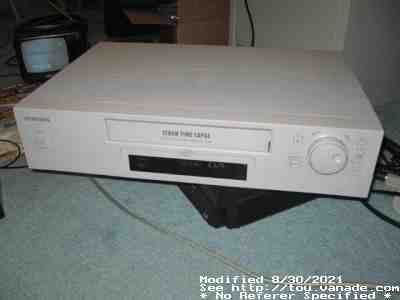Samsung SSC-1280 1280H Time Lapse VCR

The Samsung SSC-1280 is a 2-headed, standard monaural audio VCR.
Well, not just any old VCR, but a closed circuit TV time lapse VCR. It does
not have a tuner (though there's space for one as the chassis is probably
shared with its normal VCR bretheren.)
The time lapse VCR was used to squeeze more hours onto a standard T-120
VHS cassette which normally holds 2 hours in SP or 6 hours in EP mode.
Mechanically it's about the same as any other VCR, but it
was designed to slowly advance the tape. The fastest record mode is L06
where it's virtually the same tape speed as EP on regular VCRs, resulting in
6 hours. The standard modes are 6 (L6), 18 (L18), 30 (L30), 120, 168,
240, 480, 960, and "1280" hours on each tape.
This is all with the standard T-120 tapes, with the exception for 1280 hours
that requires a T-160 tape.
It squeezes more hours on the tape by reducing the number of frames captured.
Upon playback, movement will look jumpy on the slower recording speeds as
there may be less than one frame captured every second.
You can actually hear the individual steps as the tape moves
on the modes that squeeze more than 100 hours onto the tape.
The mechanism uses a smart tape mechanism, that tries to detect where in the
tape the head is positioned, and only uses rapid fast forward/rewind when it's
sure it's nowhere near the spool ends. I don't know if it will properly
detect the "large spool" VHS tapes.
It uses a standard erase head and not a flying erase head, so it cannot erase
and record per frame, but it can play single step frames (and fields as well)
in both directions by pausing the tape using the finger controlled rotary
encoder knob.
It can also slowly or quickly step forward and backward through the tape,
and can also play in reverse though audio is disabled. A lot of old movies
with forensic investigation detail such device while looking through
surveillance videos - this is the type of device that's used!
As it's a security device, it has many feaures to integrate into an alarm
system. There are connectors to tell when it to start and stop recording,
as well as indicating when it has run out of tape. A timestamp feature
writes the current time of day onto each recorded frame.
It even has a battery powered clock that won't forget the time if you lose
power - and when you do lose power, it gets stored into the device so you'll
have a record why frames were lost.
There is a Youtube Video
where someone demonstrates the virtually identical SSC-960 VCR.
I suspect the SSC-1280 is actually the same as the SSC-960, but with a
different badge. The SSC-960 will instantly become a SSC-1280 with a T-160
tape.
I bought this at a thrift shop as I've never had a Time Lapse VCR before.
It was broken as it ate a tape that the original owner did not extract.
The fix was the mode select switch like most tape eaters, and now it no longer
is hungry.
Then the next problem shows its 'head': the picture was messed up.
It had a really weird failure mode - was very noisy,
and the top half of the screen was whited out.
Turns out, doing a thoroughly cleaning each of the heads improved it
significantly.
I'd expect the VCR has a lot of hours on it now, and the head probably has
significant wear on it - quite possibly the remaining issues are due to wear,
then again the tape I was testing with is also kind of broken as it was the
regurgitated tape with "chew marks" on the tape... But for now it actually
works just fine recording and playing. It actually will play standard
2 hour SP tapes fine, too, but has no way of recording at SP speeds that
I can find. Single frame stepping of SP tapes does not work so well however;
EP/SLP can be single frame stepping works fine.